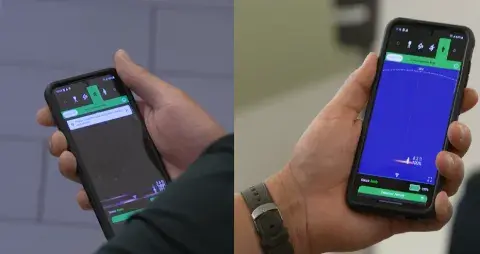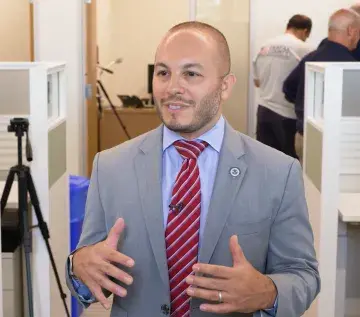Since this feature article was originally published, the Science and Technology Directorate (S&T) has moved forward with a series of first responder field assessments of the DePLife technology. The assessments, scheduled to run through October 25, 2024, will play a crucial role in refining the design and function to meet responder needs and ultimately bring it closer to commercialization. During this eight-week period, six federal, state, and local law enforcement agencies across California, Texas and South Carolina will conduct independent evaluations of the DePLife prototypes, deploying them in various operational scenarios. S&T’s First Responder Capability Program will oversee the assessments, ensuring that the tests yield actionable feedback to enhance the prototype’s precision and usability. By engaging with end users directly, S&T aims to improve the odds that DePLife will transition from a promising prototype to a trusted tool in the hands of first responders nationwide. The final phase of this project will involve gathering direct feedback from first responders and guiding any necessary final enhancements before transitioning back to partner MaXentric Technologies for commercialization. S&T will announce when DePLife is available for responder agencies.
The Science and Technology Directorate (S&T) is working on a tool that will provide first responders a better situational awareness when assessing an incident scene.
S&T is working with MaXentric Technologies LLC to enhance their Detect Presence of Life (DePLifeTM) technology, which is specifically designed to do just that—allow law enforcement to easily and safely identify whether any individuals are inside a room when direct line-of-sight is not an option. This is especially critical when conducting breaching operations, searching for trafficked individuals or in potential hostage situations, where the device gives responders precious intelligence and situational awareness while reducing the risk of physical harm to themselves.
Why first responders need to detect the presence of life
“There are many reasons why first responders need to know whether people are present in a structure, and how many are there,” said Anthony Caracciolo, S&T program manager for First Responder Technology. “First and foremost, for their operational awareness and safety. Also, to quickly get to an injured person, or to chart the best tactical course of action to take to free individuals hidden by human traffickers.”
“It is important for law enforcement and firefighters to use such technology because we want to know what's behind a wall when we go in,” said Diego Herrera of the Dona Ana County Sheriff’s Department in Las Cruces, New Mexico. “We all want to go home at the end of the shift. Too many of our guys have died going into dangerous buildings.”
S&T’s First Responder Resource Group (FRRG) first identified a need for a hands-free version of this kind of tool. Although such detection devices exist, they require someone to operate them manually, and law enforcement officers need their hands free for other purposes. For the last 30 years, technologies detecting presence of life have evolved, becoming smaller, more efficient and less costly, with better operating times as batteries improved. But the technology still needs improvements related to ease of use, ruggedness and detection precision.
“Our objective is to enhance these existing technologies to allow them to be operated hands-free or even remotely—operating the technology should not require the user to be placed directly in a hazardous environment,” Caracciolo said. “However, current detection technologies must be stationary to ‘see’ through walls. And no one has solved the hands-free, mobility requirement.”
What it takes for DePLife to ‘see’ through walls
DePLife uses radar to penetrate through common interior or exterior walls made of materials like sheetrock, plywood, vinyl/wood siding and stucco. However, it cannot penetrate through walls that contain sheets of metal or foil as metal reflects all the radar’s energy.
The DePLife device consists of two main pieces of equipment: the radar, which transmits and receives the radio wave pulses, and a user interface device, like a tablet or cell phone, where the results of the radar are displayed. The device can switch between covert and overt alerts.

“When radio wave pulses hit an object, they are reflected back to the radar; and if that object is moving, the built-in software recognizes that movement and classifies it as life. This is happening rapidly, with pulses being transmitted many times per second,” said Caracciolo. “That is how DePLife detects movement, even just breathing movement, and therefore life.”
DePLife works like radar guns that law enforcement uses to calculate the speed of moving vehicles. The difference lies in detecting an inanimate vs. a living object—the vehicle’s movement is consistent and patterned, whereas a human’s movement is not.
To operate the device, responders attach the radar to an accompanying tripod and then deploy the radar flush with the wall behind where they want to detect people. The DePLife mobile app connects to the radar via its locally generated Wi-Fi network and automatically begins streaming data. The visualization is composed of a cross-range colormap in birds-eye view with icons annotating the presence-of-life algorithm results. The DePLife app also has four different visualization tab options, each showing differently filtered results of the raw radar data. Once deployed, users must stand back at least five feet from the system to avoid being detected themselves.
Putting DePLife to the test

Over the past year, S&T conducted two operational field assessments (OFAs) to test the enhanced DePLife prototype. The OFAs assessed the performance of the technology itself and collected end-user feedback on efficiency and user-friendliness.
During the first OFA, held in October 2022 at MaXentric’s La Jolla, California, facility, S&T tested the prototype using a human trafficking scenario. Eight law enforcement officers and one firefighter tried it themselves, gauging whether it could correctly determine if a space was occupied. First, the space behind the test wall was empty. Then, one person stood behind the wall while another was laying down, and a third person walked about. The technology successfully detected all three people at the same time.
“These tests confirmed that DePLife can detect if someone's behind a wall and is moving, standing or laying down,” said Caracciolo. “The OFA was the first time for first responders to get their hands on DePLife.”
DePLife was tested both on interior and exterior walls successfully, but it performed better with the interior walls as it was designed and developed for typical interior walls.
“First responders should participate in these tests because I think they shift the paradigm on how law enforcement would get technology in our hands,” said Brad Cupp of the Las Vegas Metro Police Department. "Before, we would take what was available and try to figure out how to use it for our mission. Whereas this program allows us to have a say in what the devices need to do.”

The test was also helpful for MaXentric. “Feedback from first responders helped us improve the current prototype. And we've learned from the OFA how to make the product even easier to use,” said MaXentric technology developer Amir Levine. “S&T is a great bridge between the people doing the projects and the people using the devices.” said Levine.
Based on feedback from the first OFA, MaXentric ruggedized the technology to make it shock and weather resistant, made it more compact and easier to use, and modified it to better detect individuals standing still. Then, DePLife was again tested during a second OFA in September 2023 in Washington, DC. Tests similar to the first OFA were performed, and first responders provided feedback.
“I find a lot of benefit being part of this process,” said Chief Deputy Nicholas Lennie of the Story County, Iowa, Sheriff's Office, who is an FRRG member. “The people that have the boots on the ground know better than anybody else what they need and how they might use this equipment. Having that voice and the resources from the federal government to go behind developing these products goes a long way, something that an agency my size just couldn't do.”
What is next?
Two potential efforts for S&T lay ahead. Path 1 focuses on solving the hands-free, mobility requirement to detect life movements through a wall while the device itself is moving. S&T has entered into an interagency agreement with the U.S. Air Force and the Massachusetts Institute of Technology Lincoln Laboratory to attempt to develop a prototype that makes accurate life detections while the detector is experiencing small, micro movements like vehicle vibrations, wind, and even the breathing of the responder wearing the device.
Path 2 focuses on continued investment in the prototypes developed by MaXentric by conducting first responder field assessments. The developed prototypes currently need further improvement to increase detection precision and consistency.
“We are always striving to develop prototypes that transition to commercial products that first responders see value in and procure,” said Caracciolo. “In the case of DePLife, value is not enough. Obtaining their trust is paramount.”
For related media inquiries, contact STMedia@hq.dhs.gov.
